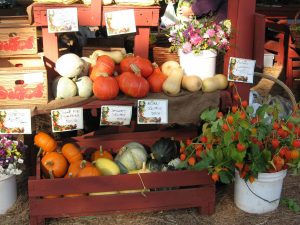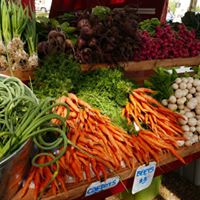This afternoon is our last Wednesday market (4-7pm), and we’re excited to end the downtown season with such beautiful weather!
The Saturday market runs through the end of October.
Fresh this Week: Pumpkins, Winter Squash, Cornstalks, Autumn Lanterns, Corn, Pears, Apples, Plums/Prunes, Melons, Peaches, Nectarines, Raspberries, Grapes, Tomatoes (including Cherry, Roma, Gold, Yellow, Salad, Indigo Rose, Campari, and Heirlooms), Arugula, Fennel, Spinach, Zucchini, Kale, Chard, Head Lettuce, Carrots, Beets, wide assortment of sweet and hot peppers (including Poblano, Jalapeno, Serrano, Pepperoncini, Shishito, Corno Di Toro, Pimento, Chocolate, Anaheims, and Habanero), Radishes, Garlic, Basil, Parsley, Cilantro, Turnips, Broccoli, Cabbage, Green Onions, Potatoes (Yukon Gold, Huckleberry Gold and Red), Red/Yellow Onions, Cucumbers (including Pickling European, Asian and Lemon), Heirloom Beans, Eggplant, Sweet Peppers, Cauliflower, Napa Cabbage, Edamame, and Leeks.
- Music by Scott Reid
- Wednesday, September 27th, 4:00 pm – 7:00 pm
- Wednesday Market Location
- Music by West Side Cobras
- Saturday, September 30th, 9:00 am – 1:30 pm
- Saturday Market Grounds
Storing Local Produce for Winter
The most frequently asked question at the Market Manager’s booth the past couple of weeks has been “how much longer is the market open?”, which is usually followed closely by a expression of regret that the season is winding down.
The good news is that we have a full month of Saturday markets left! But if you are going to miss the fresh produce grown by your favorite farmer, now is the time to think about stocking up on storable items for the winter.
Crops that store well are:
- Winter Squash
- Onions, garlic and shallots
- Potatoes
- Root crops such as carrots, beets and turnips
- Apples
Here are a few tips:
 Winter squash and pumpkins: need to be “cured” in the sun before storage. Your farmer has likely already done this before bringing them to market, but check to make sure. Look for hard skins and dried stems. Ideal storage for winter squash is a basement room or under a bed where temps are kept cool and humidity is low.
Winter squash and pumpkins: need to be “cured” in the sun before storage. Your farmer has likely already done this before bringing them to market, but check to make sure. Look for hard skins and dried stems. Ideal storage for winter squash is a basement room or under a bed where temps are kept cool and humidity is low.
Onions, garlic and shallots: Need to be “cured” as well, but it’s easy to tell if it’s been done. You’re looking for onions with tops cut off and papery skins (think store-bought onions). If the green top is still attached, it’s not cured. These store best in very cool areas like basements or insulated garages. They need airflow, so people often hang them in old panty hose, or braid and hang the garlic.
Potatoes: Choose potatoes with undamaged skin and do not wash. Wrap individually in newspaper and store in a dry, cool spot.
 Root crops: Trim green tops off to 1″ in height. Unlike the previous produce, root crops need some moisture for maximum longevity. Root cellars typically had some moisture from the ground, so you need to imitate this if storing in a dry spot. Packing root crops in shallow bins of lightly damp sand, or sawdust are recommended. Leave the lid of the bin slightly ajar.
Root crops: Trim green tops off to 1″ in height. Unlike the previous produce, root crops need some moisture for maximum longevity. Root cellars typically had some moisture from the ground, so you need to imitate this if storing in a dry spot. Packing root crops in shallow bins of lightly damp sand, or sawdust are recommended. Leave the lid of the bin slightly ajar.
Apples: You want apples to retain their moisture, so they need to be stored in bins or sawdust or straw and prevented from freezing.
With all storage crops, it’s a good idea to check them occasionally and use any that are starting to deteriorate.
Happy cooking this winter!

Leave a Reply